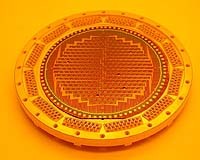
|
| ©Space Daily |
| Large Bolometer Camera (LABOCA) array wiring side. |
Space is a vast expanse which hides deep within its depths the secrets behind how the first galaxies emerged from the Big Bang. Now thanks to the world's largest bolometer camera constructed and operated by a collaborative European consortium, these secrets will slowly begin revealing themselves to scientists worldwide.
Located 5100 meters above sea level on the Chajnantor plateau in the Atacama Desert of Chile, the world's largest bolometer camera for sub millimetre astronomy is now up and running. With it, astronomers will be able to explore the evolution of the universe, the radio emissions of stars and the radiation of circumstellar molecular envelopes (radiation of stellar accretion disks), as well as the galactic core.
The Large Bolometer Camera (LABOCA) has been specifically designed for the specific purpose of researching extremely cold astronomical objects. Bolometers measure the energy of incident electromagnetic radiation and register the resulting rise in temperature, in other words operating as a sort of interstellar thermometer. This is important because a large part of all the gas found in the Universe has extremely cold temperatures of around minus 250 degrees Celsius.
Therefore, the only way these objects and gasses can be properly studied is through looking at the light they radiate in the submillimetre range, and this can only be achieved through the use of such bolometer cameras such as LABOCA. Similar to other telescopes, the bolometer has been built on high ground, but located in a very dry climate. The climate can adversely affect the bolometer in the same way light affects normal telescopes.
However, even under such optimal conditions as is found in Chile, the heat from Earth's atmosphere is still a hundred thousand times more intense than the tiny astronomical signals from distant galaxies. As a result, special software was developed specifically for the project at the Max Planck Institute for Radio Astronomy.
Indeed, the project would not have been able to proceed if it had not been for the collaborative effort between the Max Planck Institute for Radio Astronomy, the Onsala Space Observatory of Sweden and the European Organisation for Astronomical Research in the Southern Hemisphere (ESO) which represents thirteen Member States.
Already the first astronomical observations with LABOCA have revealed its great potential. By studying the Kuiper Belt Objects in the solar system, vital clues as to the formation of our own solar system and planets in general are being revealed to scientists.
It should also be noted that the only reliable way to trace the bulk of dust in galaxies is through imaging at submillimeter wavelengths. Thanks to LABOCA, now for the first time, astronomers will be able to perform unbiased surveys of the distribution of the cold dust in the Milky Way. All results, raw and reduced data are also publicly available.



Reader Comments
to our Newsletter